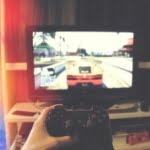Yes, it’s that time of year again. The time to get holed up in a dark room for hours along with the industry’s best TVs as they’re pitted against each other in the ultimate 4K HDR cage match. And we got a front row seat. Jealous? Thought so.
Earlier this week, High-Def Digest was invited to attend the 2017 CE Week TV Shootout held in New York City. The annual event places the year’s top displays side by side in order to choose the new “King of UHD TV.” And though now in its 14th year, 2017’s competition featured a few notable changes from previous iterations in an effort to improve transparency and judging.
First, this year’s Shootout was officially held by CE Week itself rather than former organizer Value Electronics, a leading independent audio video retailer in Westchester County, NY. Despite being the event’s original creator, Value Electronics President, Robert Zohn, graciously handed over the reins to squash any potential concerns about retailer investment in picking a particular winner. In addition, the judging was limited to three industry professionals with backgrounds in content creation and calibration rather than all the guests in attendance.
Finally, the award categories were also amended slightly this year, resulting in prizes for:
-Studio Lighting/Home Theater performance
-HDR/Bright Room performance
-Streaming performance
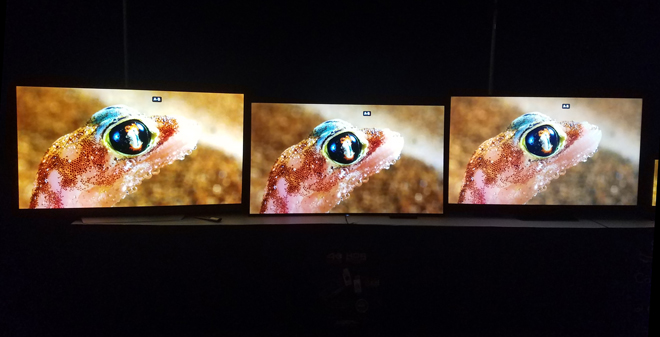
To determine the winner, the six competing Ultra HDTV models were measured and compared against each other based on various display aspects including:
-Perceived contrast (40% of score)
-Color saturation and color volume (20% of score)
-Colorimetry (20% of score)
-Motion artifacts (20% of score)
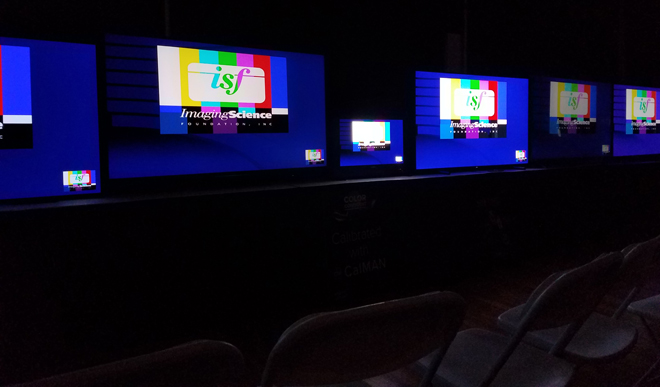
The judges then voted on the different picture quality attributes to determine a winner in each of the three categories. Joel Silver of the Imaging Science Foundation hosted the event, and evaluation sessions were conducted on July 12 and July 13.
I attended the full session on July 12 (filled mostly with press and other industry members) and the last half of the July 13 session which featured the judges and the results. Below, I’ll offer details on the competing displays used and the tests conducted, along with my own impressions of each TV and my feelings on the winners. Let the shootout begin!
Contents
THE TESTS
To properly test and compare the competing displays, each TV was calibrated to full SDR and HDR standards using high-end meters and Calman calibration software. The six competing models were all placed side-by-side. The order from left to right was as follows:
–LG 65E7P OLED Ultra HD TV
–Sony XBR65A1E Bravia OLED Ultra HD TV
–Sony XBR65Z9D 4K Ultra HD LED TV
–Samsung QN65Q9 Ultra HD QLED TV
-VIZIO P-Series Ultra HD HDR Home Theater Display
-Westinghouse WA65UFA1001 LED 4K Ultra HD TV
And as a key point of reference, a Sony BVM-X300 broadcast monitor was included as well. Used for professional mastering, this monitor offers just about the most accurate picture possible, allowing direct comparisons to be drawn to each consumer display.
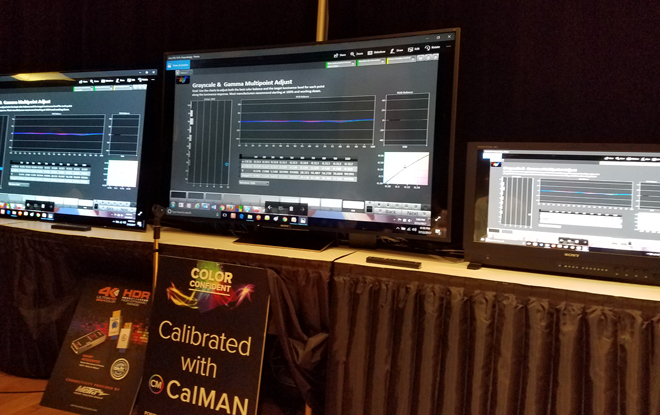
Throughout the shootout, various test patterns and clips were used to judge the different picture criteria — first with the lights off for home theater performance and then with the lights turned on for bright room performance. All tested panels were concurrently fed through a professional HDMI distribution amp from the latest 4K signal generator for test patterns. Ultra HD Blu-ray material was played back through an Oppo UDP-203.
Those familiar with typical display calibration software should have a good idea of what the evaluation process was like. Like last year, host Joel Silver walked us all through the different test patterns (in SDR and HDR) — including numerous pluges, ramps, checkerboards, and color bars — pointing out what we should look for while occasionally bringing out the meters to indicate specific results. Tests for local dimming (a thin white line scrolled across a black background and a floating white ball), 1080i deinterlacing, and a new gradient pattern for HDR nit performance were employed as well. As the various tests were conducted, Silver encouraged all of the attendees to get up close and personal with each TV. Likewise, the three judges all walked down the display line to fully evaluate each set’s performance.
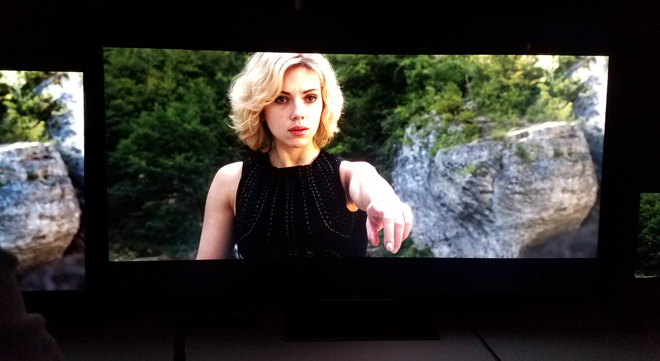
And while grayscale patterns are surely fascinating on their own, actual content was also used to help judge the displays, including Ultra HD Blu-ray clips from Planet Earth II, Lucy, and Kingsman: The Secret Service playing side-by-side in HDR10. It should be noted, however, that there was an issue with how the Oppo player was outputting content during the first evaluation session, resulting in notable banding and false contouring on all the displays when playing the Planet Earth II disc. Thankfully, this was corrected for the second day of testing when the judges were present.
Finally, for the last category of judging, all of the displays played back the Netflix short film, Meridian, using their integrated Netflix smart TV apps to compare how each set handles streaming material (models with Dolby Vision support played the film in that format while the others played it back in HDR10).
IMPRESSIONS
As I stated last year, before going into my individual impressions for each display, I do think it’s important to note just how impressive and similarly well performing most of the competing models really were. At times, it was hard to spot specific differences or weaknesses between the TVs. With that said, the test patterns and demo material did reveal a few key pros and cons.
Note: All prices below reflect current Amazon or manufacturer discounts before taxes or shipping fees.
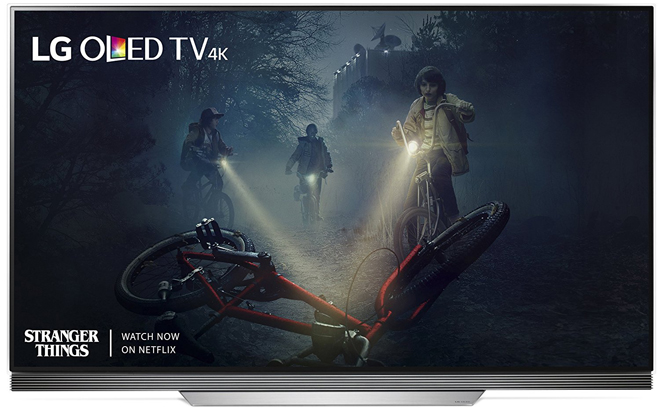
LG 65E7P OLED Ultra HD TV ($4,797) – As one of LG’s flagship 2017 OLED TVs, this model offers Dolby Vision and HDR10 support (with an HLG firmware upgrade coming soon), improved picture performance over 2016 models, perfect black levels, wide viewing angles, wide color gamut playback, a Picture-on-Glass design, and a Dolby Atmos 4.2 Ch 60W sound bar stand.
Pros – Thanks to its OLED screen, the LG E7P offered some of the most impressive black levels and viewing angles of the bunch (tied with the Sony A1E). As one of two TVs in the shootout capable of displaying true black on a pixel by pixel level, the E7 produced a gorgeous, deep inky look. Likewise, the TV offered very strong performance for perceived contrast in a dark room, and though not the best performer when it comes to HDR, the test pattern revealed a measurement around 700 nits. With these factors in play, the TV was one of the most well rounded of the bunch and came the closest to matching the picture of the reference broadcast monitor.
Cons – As fantastic as the LG OLED was, the display was not quite perfect, particularly when it came to bright room performance. In this category, the Sony and Samsung LCD sets clearly had an advantage, allowing for a brighter picture that maintained their pop better even with the lights on. Likewise, the TV featured a bit more visible noise when looking closely at the panel compared to the LCDs and the Sony OLED, but this really wasn’t an issue from a normal viewing distance.
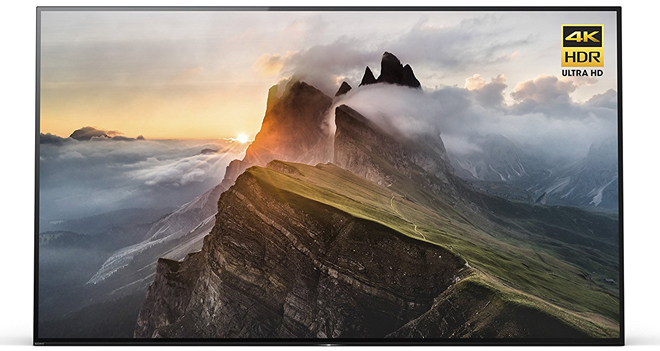
Sony XBR65A1E Bravia OLED Ultra HD TV ($4,998) – Sony’s first big-screen OLED uses the same panel as LG’s model while incorporating Sony’s own proprietary video engine and processing. Key features include HDR10 (Dolby Vision and HLG via future firmware update), perfect black levels, wide color gamut playback with Triluminos tech, wide viewing angles, and a unique Acoustic Surface sound system that produces audio directly from the screen itself.
Pros – Almost identical to the LG model, the Sony OLED basically offered the same pros with equally good black levels and viewing angles, nearly tying for best home theater performance in a dark room. In addition, the set also offered slightly superior video processing compared to the LG, resulting in a little less noise when up close and personal with the TV.
Cons – While picture quality was almost the same between both OLEDs, the Sony looked just a little dimmer compared to the LG in most instances (though some meter readings proved this wasn’t always the case). To this end, the HDR test pattern showed results a little under the LG. In addition, the Sony panel featured a slightly more teal tinge to its color, making the LG’s image ever so slightly closer to the reference monitor’s picture.
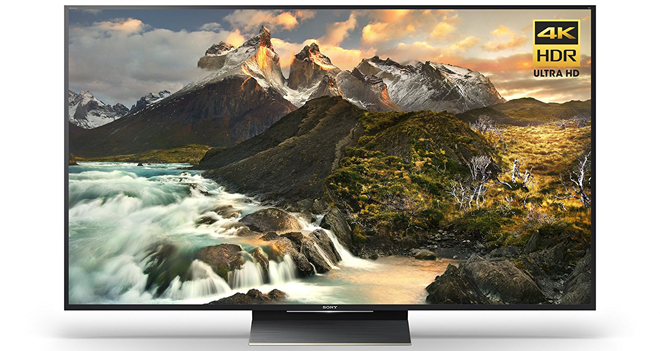
ony XBR65Z9D 4K Ultra HD LED TV ($5,498) – Though technically a 2016 model, the Z9D was not yet available during last year’s Shootout and remains Sony’s flagship LCD display. The TV features full-array local dimming, wide color support, and HDR10 performance. Likewise, the set will reportedly receive a Dolby Vision firmware update later this year.
Pros – Demonstrating that LCD tech still isn’t down for the count, the Z9D was capable of producing the brightest picture and the most impressive HDR performance. To this end, the HDR test pattern revealed levels over 1,000 nits. Likewise, while not quite as impressive as the OLED panels, the display’s full array local dimming allowed the TV to produce deep, inky black levels from a direct viewing angle. For these reasons, I thought the TV offered the best bright room performance.
Cons – Though fantastic from a direct view, the Z9D suffered from off-angle viewing, resulting in washed out colors and black levels compared to the OLEDs. Some light blooming from the TV’s local dimming feature was also visible in dark scenes with isolated bright lights — including a sequence from Planet Earth II with glowing eyes. And while the TV actually had some of the most accurate grayscale readings, the picture looked just a hair warm compared to the reference monitor.
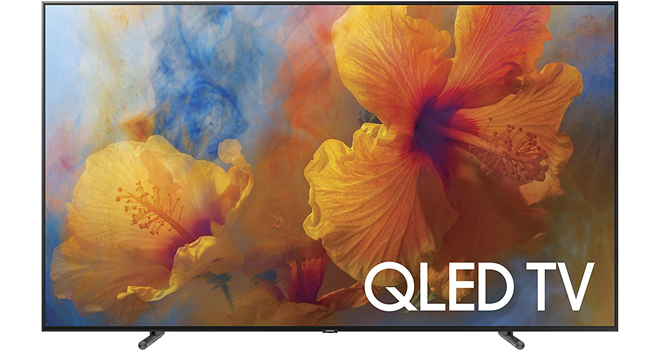
Samsung QN65Q9 Ultra HD QLED TV ($3,998) – Samsung’s flagship 2017 Ultra HD TV uses new metal quantum dot technology to deliver wide color gamut support and 100 percent color volume. Likewise, the set includes HDR10 support and is among the first displays to include new HDR10+ support (but not Dolby Vision).
Pros – The Q9 was capable of getting brighter than the OLED panels offering great light room performance. Likewise, the set was capable of strong HDR performance, with the test pattern showing around 1,000 nits.
Cons – Sadly, all of the lingering flaws of LCD tech were readily apparent with this set. The edge-lit local dimming panel did not do a good job of creating deep black levels, resulting in grey blacks, clearly visible clouding, and uniformity issues. To this end, one could see the LEDs shifting brightness at the corners of the screen during the local dimming test and dark content. In addition, viewing angles were also subpar compared to the OLEDs. Overall, this was one of the least impressive models when viewed in home theater conditions.
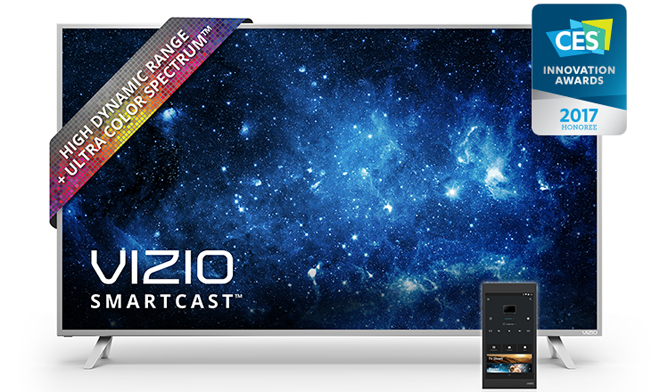
VIZIO P-Series Ultra HD HDR Home Theater Display ($1,700) – VIZIO’s flagship 4K display includes full-array local dimming with 128 zones, Dolby Vision and HDR10 support, and wide color gamut support. With that said, the display does not include a TV tuner.
Pros – While the VIZIO P-Series display was not the top performer in any of the categories, the set held its own remarkably well against the much more expensive competition. Local dimming performance was very good (though not quite as good as the Sony) resulting in very strong black levels from a direct angle, and though toward the low end of the pack, HDR performance was still solid with about 600 nits in the test pattern. Backlight uniformity was also much better than the Samsung and Westinghouse.
Cons – Like all of the LCDs in the Shootout, viewing angles suffered from the side. And though local dimming was very good overall, the white line noticeably pulsed during one of the test patterns as it moved across zones, and a scene from Meridian where a character held a flashlight also revealed some blooming.
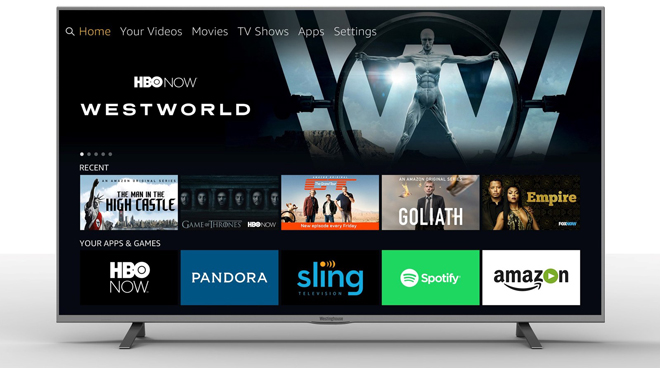
Westinghouse WA65UFA1001 LED 4K Ultra HD TV ($650) – Westinghouse’s new 4K Ultra HD TV is geared toward budget conscious buyers and features the Amazon Fire TV platform for streaming apps. Though the TV’s listed specs make no mention of HDR support, it was apparently able to at least receive an HDR signal properly during the Shootout.
Pros/Cons – No disrespect to Westinghouse, as this is a model geared toward a completely different budget level compared to the rest of the displays featured here, but the WA65UFA1001 really did not hold its own in this lineup and probably should not have been included in a Shootout with these premium flagship models. Though not a terrible performer for the price, this was the least impressive display across the board with subpar accuracy, comparatively harsh, exaggerated colors and poor black levels and uniformity.
WINNERS AND FINAL THOUGHTS
When all was said and done, the LG 65E7P OLED Ultra HD TV was crowned the winner in all three categories by the panel of judges, claiming top awards for Best Studio Lighting/Home Theater, HDR/Bright Room Performance, and Streaming Performance. This marks the fourth year in a row that an LG OLED has won the prize. The Sony XBR65A1E Bravia OLED Ultra HD TV came in at a very close second and received a special honorable mention for Best Studio Lighting/Home Theater performance.
While I completely agree with LG’s win for Home Theater performance, I’m actually a little surprised the OLED panel snagged the best HDR/Bright Room award. Based on what I saw (and ignoring viewing angles), the Sony XBR65Z9D 4K Ultra HD LED TV was the clear winner for HDR with the lights on. Meanwhile, Streaming performance was more of a toss-up for me, as I didn’t really see any of the displays stand out in this regard.
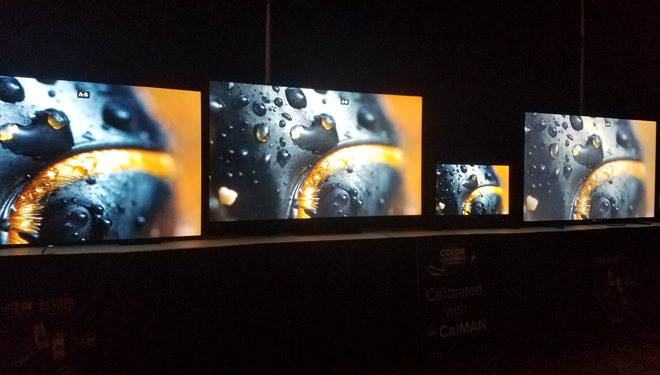
Still, it’s hard to begrudge the panel for their selection. The LG OLED really was the closest to the reference monitor across almost all of the tests and material. Likewise, it was simply the best overall performer, especially when playing back the featured Ultra HD Blu-ray discs thanks to its inky blacks and HDR highlights.
Here’s my own rankings for Best Home Theater Performance from the Shootout:
–LG 65E7P OLED Ultra HD TV
–Sony XBR65A1E Bravia OLED Ultra HD TV (almost tied for top spot)
–Sony XBR65Z9D 4K Ultra HD LED TV
–VIZIO P-Series Ultra HD HDR Home Theater Display
–Samsung QN65Q9 Ultra HD QLED TV
-Westinghouse WA65UFA1001 LED 4K Ultra HD TV
High-Def Digest would like to extend a big thanks to the folks over at CE Week and Joel Silver and his team for hosting the event. Likewise, another big thanks to Robert Zohn for starting the Shootout and ensuring that it remains in good hands.
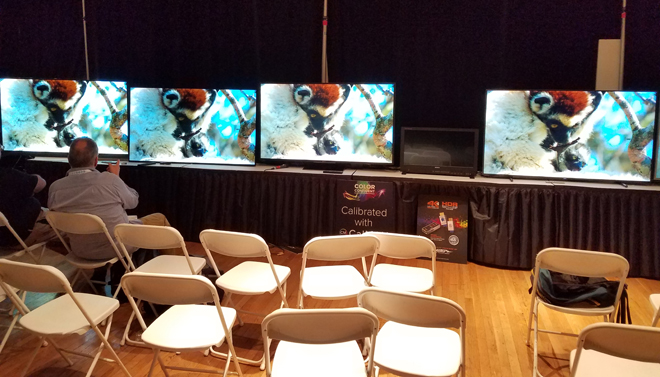
We’re looking forward to seeing what next year’s competition has in store, but for now, what do you think about the 2017 CE Week TV Shootout results? Do you own or plan to buy any of the participating displays? Let us know your thoughts in the forums!
[“Source-highdefdigest”]


